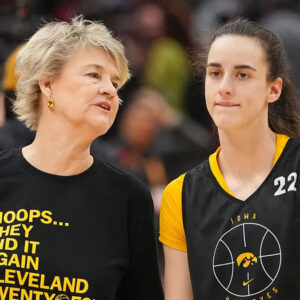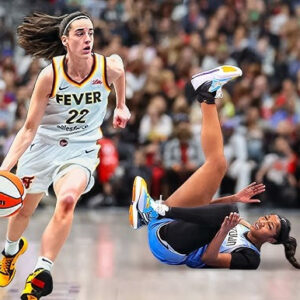
Caitlin Clark entered the WNBA season with higher expectations than any rookie in recent memory. Not only was she tasked with leading the Indiana Fever back to relevance after a seven-year playoff drought, but the fate of the WNBA itself was put on her shoulders after she sparked a rapid increase in the popularity of women’s basketball at the college level.
Caitlin Clark entered the WNBA season with higher expectations than any rookie in recent memory. Not only was she tasked with leading the Indiana Fever back to relevance after a seven-year playoff drought, but the fate of the WNBA itself was put on her shoulders after she sparked a rapid increase in the popularity of women’s basketball at the college level.
At times, it seems like too much has been asked of the 22-year-old from Iowa, especially as she and the Fever began the season on an 11-games-in-20-days gantlet littered with nationally televised contests against the best teams in the league. A 2-9 start when Clark had one double-double, three single-digit scoring games and more turnovers than rebounds seemed to only confirm suspicions that WNBA dominance would be a ways away for the college superstar.
But that shaky start has become a distant memory. Clark has figured out the pro game on the fly. She leads the WNBA in assists (8.3 per game) and total points created (1,012) via points and assists. Indiana already has as many wins this season as it did a year ago and is tied for the fourth-most victories in the league since the start of July. Clark has also etched her name in the league’s historical record. Against the Seattle Storm on Sunday, she set the record for most assists by a first-year player, passing WNBA legend Ticha Penicheiro with 12 games to spare. Clark also has the most assists in a single game, dishing 19 dimes in a loss to the Dallas Wings before the Olympic break.
Nearly three-quarters of the way through her rookie season, it’s fair to say Clark is putting together one of the best first seasons in league history, particularly from the guard position.
“It’s amazing what Caitlin’s been able to do in her short career so far, it’s just been nothing short of remarkable,” Diana Taurasi said. “The one thing that I really love about her is she loves the game. You can tell she’s put the work in. And even throughout her short WNBA career, it’s been a lot of pressure, a lot of things thrown at her, and she keeps showing up and keeps getting better every single game. So her future is super bright.”
Taurasi knows how challenging the league is for young guards. Thinking back to the great drafted rookies in WNBA lore (and not some of the inaugural players who debuted at later ages like Cynthia Cooper and Sheryl Swoopes), they were almost all frontcourt players. Tamika Catchings was second in defensive player of the year voting and third on the MVP ballot during her first year as a small forward. Candace Parker won MVP as a rookie at the power forward position. Over the last decade, Breanna Stewart, A’ja Wilson, Napheesa Collier, Aliyah Boston and Angel Reese have been All-Stars as rookies. Only Rhyne Howard joins Clark on the list of guards to earn that honor.
Sue Bird is widely regarded as the best point guard in WNBA history. She averaged 14.4 points and 6 assists per game in her debut season with the Storm in 2002. Clark’s averages of 17.8 points and 8.3 assists comfortably exceed Bird’s marks, and the Indiana rookie also has a higher field goal percentage. As Clark enters the end-of-season awards discussion, consider that Bird was a first-team all-WNBA selection for her output as a rookie.
Notable WNBA rookie guards
1998
Ticha Penicheiro
6.2
4.7
7.5
33.3
2002
Sue Bird
14.4
2.6
6
40.3
2004
Diana Taurasi
17
4.4
3.9
41.6
2017
Kelsey Plum
8.5
1.9
3.4
34.6
2024
Caitlin Clark
17.8
5.8
8.3
41.2
Taurasi was also the first pick when she entered the WNBA 20 years ago. Now the league’s all-time leading scorer by a large margin, Taurasi put up 17 points per game as a rookie. It was a different offensive environment, as WNBA teams averaged 67.1 points during the 2004 season compared with 81.7 in 2024, but outpacing Taurasi in her first season — again, a first-team all-WNBA campaign for the former UConn guard — paints a pretty picture of what Clark has accomplished as a scorer. Since Clark has taken a higher volume of 3-pointers than Taurasi in her first season, she also has a higher effective field goal percentage than rookie Taurasi did.
What about Clark’s childhood idol Maya Moore? Clark bests her in every counting stat other than 3-point percentage, though Moore was a superior force on defense and surrounded by much more veteran talent as the Minnesota Lynx won a championship in 2011.
Even moving into the modern era of the WNBA, Clark compares favorably to high-profile guards. Arike Ogunbowale is the lone first-year perimeter player to have a higher scoring average (19.1 ppg in 2019) than Clark in the past decade, but Clark has more than doubled the Wings star’s assists (3.2) and rebounds (2.4).
Future Olympians like Jewell Loyd, Jackie Young and Sabrina Ionescu all took three or four seasons to get to All-Star level production after being No. 1 picks. Even prolific college scorers like Kelsey Plum and Kelsey Mitchell — who were the top two scorers in NCAA women’s basketball history before Clark and Dyaisha Fair climbed the list in 2024 — didn’t burst onto the scene as bucket-getters in the WNBA. Plum and Mitchell averaged 8.5 and 12.7 points in their rookie seasons, each shooting 34.6 percent from the field as they acclimated to the higher level of play. Now, the pair are multi-time All-Stars, among the best shooting guards in the league, and admirers of Clark’s ascension.
“She’s tremendous,” Plum said during All-Star Weekend. “I think she’ll end up being one of the greatest players we’ll ever see in this league. The way that she’s handled everything with so much grace and just continues to go out and perform at a high level just speaks to who she is.”
It was never a doubt that Clark eventually would rise to the level of those peers, but the speed of her arrival is unique. The adjustments players normally make during the offseason have come between games. She and Boston are thriving in the screen-and-roll game as they figure out where to set the picks — Clark loves her drag screens up high; now, Clark has more assists to Boston (73) than any other combo in the league. The traps and blitzes that bedeviled her to start the season have turned into crisp passes to Boston in the short roll, leading to open jumpers for her Indiana teammates.
Is Caitlin Clark the WNBA’s best rookie guard of all time? She’s making a strong case
Clark has picked apart defenders sitting on her left hand and made hard drives to the basket with her right. Her 3-point percentage (34.7) since those first 11 games is above league average. She’s reined in her turnovers ever so slightly, bringing them down from 5.7 per game in the first month of the season to 5.5 the next month and now 5. Most importantly, the changes have all led to more wins for the Fever. They just completed a season sweep of the Phoenix Mercury and have collected wins over the New York Liberty, Minnesota and Seattle — teams ahead of Indiana in the standings, though perhaps not for long.
Clark and the Fever had to travel through fire during the first part of the season, but they’re reaping the rewards now. Indiana has the second-easiest remaining schedule and has looked the part of a contender in the two games since the Olympic break, with Clark averaging 26 points and 9.5 assists in the two wins. She has been a quicker study than most, but the time off has supercharged her performance.
The WNBA’s veterans might have had an experience advantage over Clark when the season tipped off, but that margin has eroded. Clark is in the midst of a season for the ages. That she’s a rookie only means the bar will continue to be raised during her already historic career.
Relative Articles
None found





